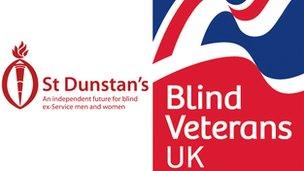Why image is crucial for a charity to secure donations
- Published
Oxfam's new boss Mark Goldring saw firsthand how the profits from one shop could buy livestock to help families in Zambia
When Mark Goldring joined Oxfam as chief executive in April this year, the charity's income had fallen. It fell by nearly £18m last year, with revenue from its two main sources, shops and fundraising, both down on the previous year.
To better understand the business from both a staff and customer point of view, he decided to spend some time working as a shop volunteer and in the field in Africa.
After volunteering on the shop floor in Oxfam's Bury branch in Greater Manchester, he found a lack of understanding from both volunteers and customers about what the charity actually did and how it spent its money.
For instance, he calculated that one week's profit from the Bury shop would enable Oxfam to buy two cows in a village in Zambia to initially help two families to make a living, but subsequently would enable many other families to make a living as the calves were passed on.
But no-one in the shop was aware of that.
"We need to show both the volunteer and the customer a bit more about the difference [their contributions] make day to day," he says.
Blind Veterans UK
This kind of disconnect between what charities do and people's perception of what they do is common.
In the 1950s, the charity St Dunstan's was a household name famed for its work with blind former military personnel. Yet in 2010 its research showed few people under the age of 75 were aware of the charity or what it did.

Before and after: St Dunstan's rebranded as Blind Veterans UK with a more striking logo
It hired consultancy Spencer du Bois to help it rebrand. After a two-year process surveying the general public, staff, volunteers and supporters, it renamed itself Blind Veterans UK with a new logo based on the union flag. The rebranding process cost the charity £90,000 but it expects it to help raise an extra £7m over five years.
And according to market research firm nfpSynergy, 22% of the British public said they would consider supporting the rebranded charity, compared with 16% before it was rebranded.
While many people may believe that charities do not need to focus on branding as much as profitable organisations, Max du Bois, executive director at Spencer du Bois, disagrees.
"It's as important in the charity sector as it is in the commercial sector. It's a way of getting people engaged with what you do," he says.
Joe Saxton, director of nfpSynergy, says: "When you give £50 to a charity, the only thing you have to judge whether your gift is well spent is the reputation and the image of the organisation.

Donations to Oxfam can be used to buy cows for people in Zambia
"In the absence of the concrete and the tangible, the intangibles of image, personality and reputation have a much greater importance."
Persuasive evidence
However, Vicky Browning, director of CharityComms, an industry body that aims to improve how charities communicate, admits it can be hard for charities to justify spending on measures such as brand that do not show instant, tangible results.
To help the cause, it recently produced a guide to branding best practice, which cites the case of Macmillan Cancer Support.
Since its 2006 rebrand, it has seen both its brand recognition and market share increase rapidly. Awareness among its core audiences of people diagnosed with cancer and their families and friends rose from 41% and 38% respectively to 65% and 66% between 2006 and 2011. In the same period, fundraising income increased from £97m to £141m.
"We live in tough economic times. Supporters have tightened their belts and organisations are zeroing in on efficiency and value for money," says Ms Browning.
"More than ever, charities must demonstrate how their cause is unique, effective, relevant and worthy of support. A charity's brand is key to achieving this."
Compelling stories
Oxfam's Mr Goldring realises that how the charity communicates with the public is key.
"We can't just say, 'The world is poor, you're guilty'. So we've got to find new ways of telling those stories.
"We need to remind the public that they can actually convert their surplus clothes into cows for people in Zambia, into crops for people in Zimbabwe, into healthcare for people in Cambodia very easily. 'This is the difference you can be making, do it.'"
The charity is now planning to launch a major campaign on 26 December to reinforce this message about what donations can achieve.
"It won't be, 'You'll be saving lives tomorrow,' but, 'You'll be strengthening lives forever,'" he says.
Escape from the Boardroom is a five-part series, starting on 21 September, broadcast on BBC World News on Saturdays at 02:10 and 15:10, and Sundays at 09:10 and 21:10 (all times GMT).
- Published27 September 2013
- Published20 September 2013